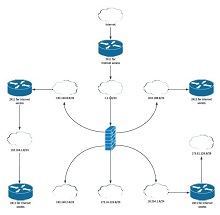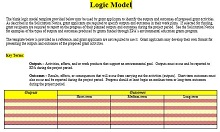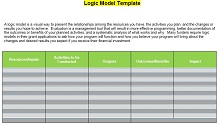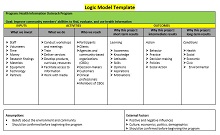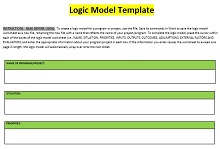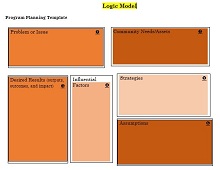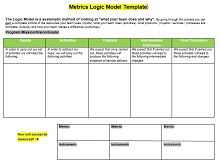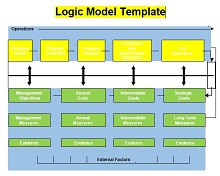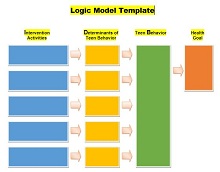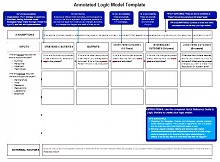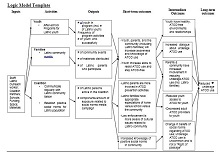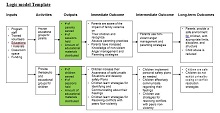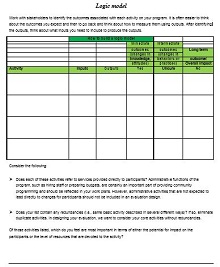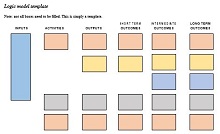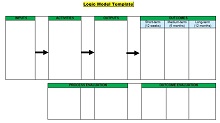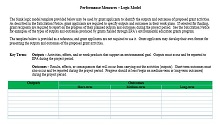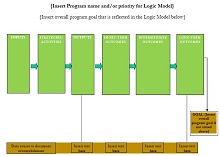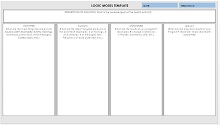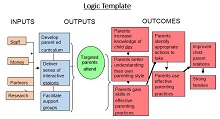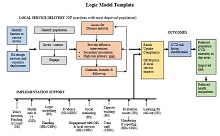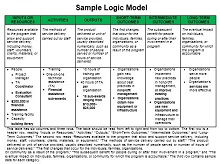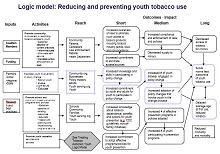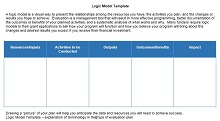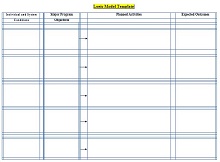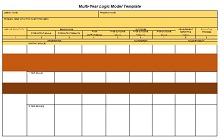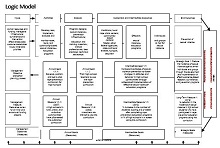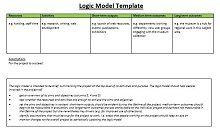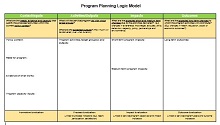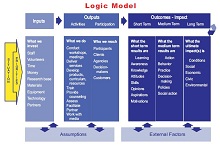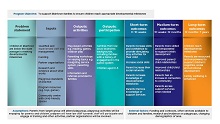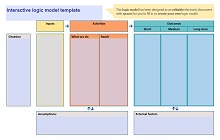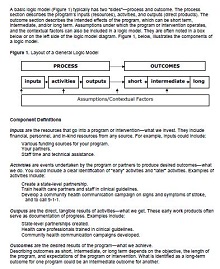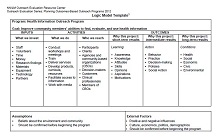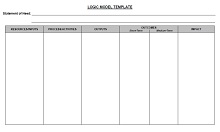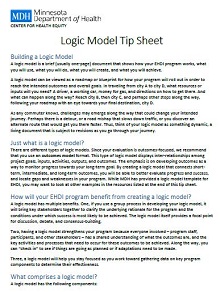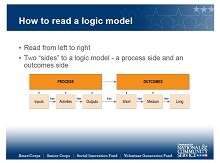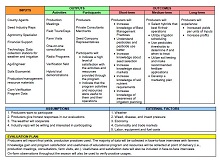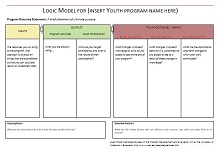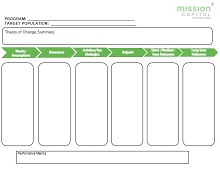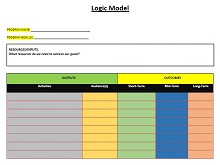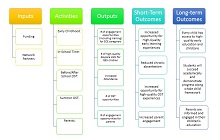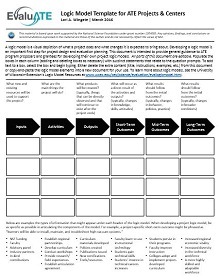55+ Free Logic Model Templates & Examples
Logic models are used to describe the resources, activities, and outcomes of a program. It depicts how the organization achieves its desired targets. It is used to display the flow of the process, which shows how you achieve your goal. It describes the whole process from start to end.
The main purpose of a logic model template is to represent the critical points of a program. Logic models are program planning tools. The logic model template helps you to understand and communicate your program to everyone. Logical model templates are used to describe the inputs, resources, activities, and output of the program. Logic models work as a planning tool to present how a program will achieve all the desired goals.
Download Free Logic Model Templates
Download the logic model template to describe how your program works. You find these templates printable and customizable in Word, PPT, and Excel format to map out the project’s resources, activities, and outcomes. It is the best way to display the resources in your program, which activities are performed, and the intended results.
You can develop a simple or complex logic model depending on the audience to whom you describe your program. There are many simple or complex logic model templates and examples that help you develop a useful model for your project. Before developing it, you should understand it clearly. In this article, you’ll know all about the logic model that helps you develop it effectively.
- Accounting Templates
- Art & Media
- Budget Templates
- Business Templates
- Calendar Templates
- Certificates
- Charts
- Education Templates
- Inventory Templates
- Invoice Templates
- Letter Templates
- Medical Templates
- Personal Templates
- Project Plan Templates
- Timesheet Templates
What is a logic model?
The logic model is a graphical representation of a program’s input, output, and outcomes. It is an effective tool to describe a program’s objective and intended impact. A graphical illustration of the program’s workflow and process helps to communicate your program with outside people concisely.
The team members involved in this project can easily understand their responsibilities and tasks with the help of this model. It includes the input of a program, which means the resources of this project (people, equipment, material), details about activities performed to achieve the objectives and goals of this program, and outcomes that define the intended impact of this project.
You can develop a logic model for public health, social work, school programs, and different projects with the help of templates available in our collection. These blank templates are the best option to show how a program will achieve the desired goals. Project management is lengthy and challenging work. You need lots of time to make plans for the resources and identify the goals, tasks, and outcomes of a project then this model is used as a road map to represent the relationship among these things.
You can track the progress of the program with project charter templates to get the desired results. Different formats of logic models are used for various purposes; the complex format describes the influence of this program on the organization and the outside world, whereas, in the simple format, it contains input, activities, and output details of the program.
Why do we need a logic model?
A logic model is a useful tool to communicate with the outside world with your assumption of a program. It is the best way to describe your resources, and define activities for the team members, and outcomes to explain the impact of this program. The reasons to use this model are as follows:
- Program planning: Planning any program leads to achieving the desired results. It is the best tool to state the execution and outcomes of the program. Stakeholders of a project want to know the project scope; then, a logic model is the only best way to describe the process of your program graphically.
- Internal and external communication: logic models describe your whole project on one page where the team members understand their responsibilities effectively. You can communicate with the other people in your program who are indirectly involved in this program.
- Engage to achieve the goals: When the objectives and goals of a program are stated on paper, it engages you. The goals described in the logical model lead you to take action to get the desired goals of this project.
- Implementation of the program: You can complete a process if each team member’s responsibilities are well defined, and the process leads you to achieve the desired results.
- Evaluating program effectiveness: The program evaluation process allows you to control the factors that lead your program to the desired results. The logic model is the best tool to measure the effect of the program. It helps you to make improvements in the process of this project to achieve the desired results.
Components of a Logic Model
The logic model works as a road map to present the main elements of a program. The components of this model provide a useful overview of the program. There are simple or complex formats of logic models to describe the functionality of the program. You can download the logic model templates in PDF, Word, and Excel formats to handle the program efficiently. A typical logic model template contains four components, the input, activities, output, and outcomes of the program. The details of each element are as follows:
- Input: This model’s input section describes what resources or efforts are used to complete this project successfully. The identification of the funds helps you to determine the budget of your program. The planning of resources includes the staff, material, funding, and equipment you need to complete this program.
- Activities: The activities of the program define the actions performed to accomplish the program. The strategies are described in this section which shows how resources will be used to get the desired results.
- Output: The outcomes provide a piece of proof that the project gets the desired results by following activities. Sometimes, the person responsible for developing the program’s logic model sets a target of work to achieve in a specific time.
- Outcomes: Outcomes are the program’s impact on the organization and the people for which this program is developed. The effects of the program may differ from short-term to long-term. The short-term outcomes are changes in knowledge and skills, which lead to the midterm outcomes that show the changes in behavior then long-term outcomes change the condition of life.
All the above elements of the logic model adequately describe your projects graphically. There are a variety of logic model templates in a table format that effectively develop a basic logic model for your program. You can add more elements to make it more detailed and complicated to show the influence of this program outside the world.
Three Approaches to the Logic Model
The different formats of logic models allow us to develop the logic model for different purposes by using different approaches. The approach to developing the logic model is selecting according to your program’s objectives and aims to describe the planning, implementation, and evaluation of the program. Below we share the three approaches or ways to handle your situation effectively.
- Theory approach logic model: A logic model provides a structural overview of the program. When a project is designed based on theory, then the theory approach logic model is the best way to describe it. This approach of the model provides a theoretical rationale to explore how certain activities are implemented to achieve the desired results. The theory approach model explains how the program will process to make expected changes. It emphasizes the project’s issues for a solution and a theory-based strategy upon which activities are performed for the expected results.
- Activity approach logic model: This type of logic model is used to define how a program’s actions will be performed by using the program’s resources to achieve the expected outcomes. It represents the purpose of each activity and details the activity’s start and end. You can provide an overview of the program by describing the implementation process. The team member who is involved in h
- Outcomes approach logic model: The outcome approach logic model describes the relationship between the program’s activities and objectives. It represents the outcomes of the program that is the result of certain events. This logical approach demonstrates which set of work you achieve in the short or long term with specific activities and the factors that impact the program’s outcomes.
How to develop the logic model
Many profit and nonprofit organizations develop the logic model of their program to complete it successfully, achieve the desired results, and communicate the program with other people who are directly or indirectly involved in this project.
You can download the logic model templates for a nonprofit organization to describe your project graphically. If you are a hardworking and smart person, then developing a logic model is not difficult, but it is lengthy and time-consuming. The fillable and editable logic model templates save you time and effort to develop a roadmap for your program. Below are the points to build the logic model.
- Problem statement: A problem statement is a description of the issues or problems you will solve with the completion of this project. It states why you need to develop this program and what issues are addressed by this program. The problem statement of a program should be written clearly and concisely to describe the problem for which the developer decides to design it.
- Define goals: Write down the goals that you want to accomplish to solve the problem mentioned in the problem statement section. State the goals and objectives of a program.
- Identify the project resources: Now, it’s time to identify what resources are available to make this program successful. The program’s resources include the staff, material, equipment, and funding that you require to accomplish the objectives of this program.
- Define the actions performed: Activities in a program are events or actions performed to bring the expected results. The activities section of the logic model describes each team member’s responsibilities and a description of how the program will use the resources to achieve the desired goals and objectives.
- Determine the output: You should provide a volume of work as proof accomplished by the activities mentioned in the activity section.
- Identify program outcomes: It measures the program’s impact on those people for whom this program is designed. The effect of the program is different in the short, mid, and long term.
Pros and Cons of the Logic Model
The logic model is a useful tool to provide a detailed description of your program. It contains the details of the planning, implementation, and evaluation of a program. There are lots of benefits of logic models with few disadvantages. Below are some essential pros and cons of logic models.
The pros:
- The model helps to describe the main component of the program.
- Helpful to measure the short or long-term impact of a program.
- The model is a road map that shows how the program will process to achieve the desired objectives and goals.
- Identification of the problem and solution is easy.
- Help the team members to understand their responsibilities and tasks in the process of this program.
- Helpful to communicate the program with the outside world.
- The objectives and goals of the program are clearly defined.
The cons:
- It is time-consuming.
- Don’t focus on unexpected results.
How to create a logic model template in Word
The logic model is used to illustrate the relationship between different components of the program. You can see the logic model sample of different formats that help you create a useful piece of paper to describe your project.
- #1: Open a blank document in Microsoft Word.
- #2: Create the header of your document by selecting an appropriate font style.
- #3: Create two labels “problem statement” and “goals” to define the problem statement and goals of the program.
- #4: Go to the “Insert” tab and click on the table option. Select the “draw table” from the drop-down menu.
- #5: Drag four columns on the document that are not connected and make the header of columns “input,” “activities,” “output,” and “outcomes.”
- #6: Select the block forward arrow from the “shapes” collection and place it between each column to display the relation between the components block of the logic model
- #7: To save your document, go to the “file” tab and click on “save as.” Write the name of your document and click ok.
Frequently Asked Questions
What is the purpose of the logic model?
The logic model’s primary purpose is a graphical representation of the input, activities, and output of a program and shows the relationship between these components.
What is program theory?
The theory of the program states the assumption that the program implementation will achieve the desired goals.
How many approaches to logic model?
There are three approaches to the logic model: theory, activities, and outcomes logic model.
Who uses logic models?
The logic model of a program is used for different purposes. It is used by the project planner, implementer, stakeholders, and the manager to handle the project’s process.
What are the activities in the logic model?
Activity is a central component of the logic model where the program’s actions are defined, which are performed in the process of achieving the program’s goals.
What makes a good logic model?
The graphical representation of the program’s design makes your model useful and easily understandable for others.

